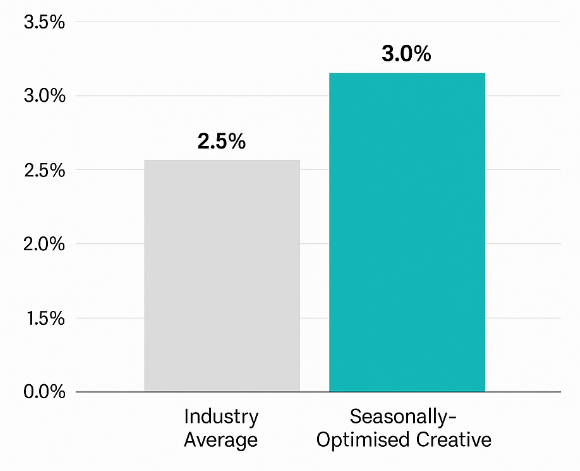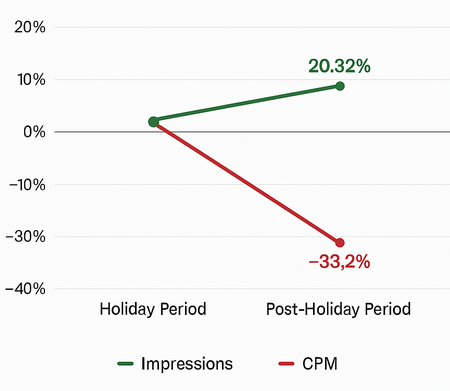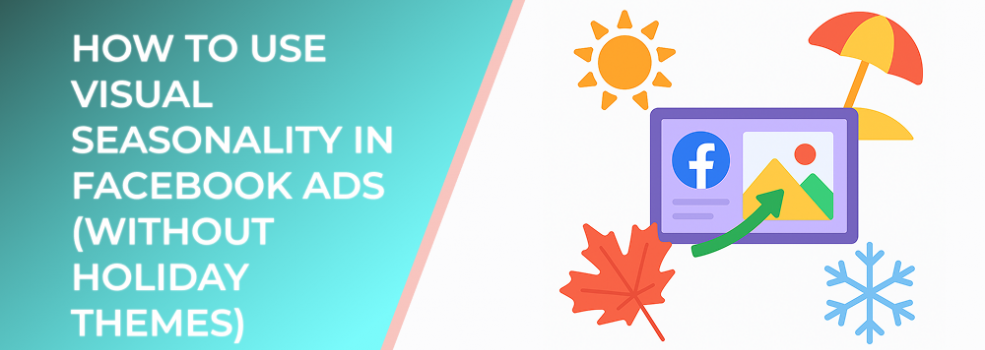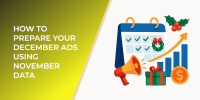Seasonality doesn’t only exist during major holidays. Consumer behavior shifts subtly throughout the year based on weather, routines, moods, and cultural cycles. The challenge is capturing these shifts without resorting to traditional holiday visuals that can feel repetitive, overly promotional, or misaligned with your brand.
Visual seasonality gives you a way to adjust creative direction based on the time of year while keeping your ads timeless, relevant, and fresh.
Below is a practical framework for tapping into seasonal cues that influence user behavior and increase ad engagement.
Why Visual Seasonality Works
Even without explicit holiday imagery, seasonal changes influence what audiences pay attention to. Research shows that ads aligned with seasonal context can boost relevance scores by up to 20% and raise engagement rates by 15-25%. Users respond more positively when the visual tone of an ad reflects the environment they’re currently experiencing.

Average Facebook Ads CTR vs. Creatives aligned with seasonal visual cues (hypothetical uplift)
This effect is not tied to a specific celebration but to atmosphere.
Core Types of Non-Holiday Visual Seasonality
1. Color Palettes That Match the Season
People instinctively associate seasons with specific tones:
-
Spring: soft greens, warm neutrals, light pastels
-
Summer: saturated blues, bold accents, high-contrast scenes
-
Fall: rich oranges, muted browns, golds
-
Winter: cool blues, crisp whites, deep contrasts
Studies show that color-optimized creatives can increase recognition by as much as 80%. Using time-of-year palettes helps your ads feel naturally aligned with the user's world.
2. Environmental Cues (Without Being Themed)
Instead of pumpkins, snowflakes, or fireworks, use subtle background elements:
-
Sunlight angles and brightness levels
-
Indoor vs. outdoor settings
-
Weather cues such as overcast skies, warm light, or reflections
-
Clothing textures (light fabrics vs. layered tones)
These cues create seasonal relevance without forcing a theme.
3. Behavior-Based Visuals
Seasonality also affects routines:
-
Early-year: planning, organizing, budgeting
-
Mid-year: travel, activity, socializing
-
Late-year: reflection, learning, resetting
About 60% of purchasing decisions are influenced by current lifestyle patterns. Showing relatable behaviors in your visuals helps users feel an immediate connection.
Creative Strategies for Seasonal Alignment
Adjust Your Mood Boards Quarterly
Create 4 mood boards representing atmosphere rather than holidays. Include color palettes, texture references, lighting examples, and style notes.
Run A/B Tests Based on Seasonal Variants
Test two versions of the same concept:
-
One with a seasonally adjusted palette
-
One with a neutral palette
Advertisers often see 10–18% performance lifts in click-through rate when seasonal variants are applied.
Use Season-Neutral Subjects with Seasonal Lighting
Lighting has a major psychological effect. Shifts such as warmer hues in late summer or crisp lighting in winter subtly influence user perception.
Lean on Minimalist Visuals During Heavy Ad Seasons
When everyone else is visually loud, quiet visuals stand out. During high-volume advertising months (such as November and July), minimalist seasonal cues can differentiate your brand.
Seasonality Without Seasonal Messaging
Your copy doesn’t have to mention the season at all. Visual context alone can carry the effect.
Example: Using a cool winter-toned palette can position a product as "focus-oriented" or "refreshing," while a summer palette can communicate "energy" or "momentum."
This prevents your messaging from sounding forced, while still benefiting from seasonal resonance.
How to Prepare an Annual Visual Seasonality Plan

Post-holiday ad performance: impressions ↑20.3% while CPM ↓33.2% in one advertiser’s study
-
Analyze monthly engagement trends to spot peaks and dips.
-
Assign a visual tone to each quarter.
-
Create reusable templates with adjustable colors and lighting.
-
Update your creative folder every 90 days.
-
Review performance and refine using data from high-performing visuals.
Advertisers who update visuals quarterly often see sustained performance improvements of 12–20% over static creative strategies.
Conclusion
Visual seasonality allows you to stay relevant, modern, and in tune with your audience without relying on clichés. By using subtle environmental cues, mood-based color palettes, and behavior-driven concepts, you can create ads that feel naturally aligned with the user’s mindset.
This approach works year-round and helps your campaigns feel fresh even during saturated advertising periods.

